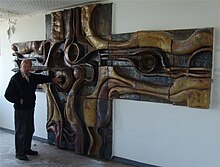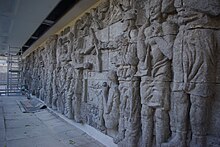Rudolf custom
Rudolf Sitte (born May 13, 1922 in Kratzau , Czechoslovakia , † March 4, 2009 in Koenigsbrück ) was a German sculptor, painter, graphic artist and art ceramist . He was the younger brother of the painter Willi Sitte .
life and work
Sitte grew up as the second youngest child as the son of a German farmer, a founding member of the Communist Party of Czechoslovakia , and a Czech mother with four brothers and two sisters. Like his brothers, he was drafted into the Wehrmacht and served in a hunter battalion until he was wounded. After imprisonment and flight, he began studying wall painting at the Dresden University of Fine Arts in 1946 . As part of the formalism dispute he was expelled in 1949 and for one year as Hauer in the bismuth sent. After the renewed forced delegation by the Wismut, he completed his studies in 1955, in which he had added an additional pedagogical course in Greifswald .
Rudolf Sitte taught as a professor at the Dresden University of Fine Arts on building-related art . As a member of the Kunst am Bau artists' association , he was involved in artistic building projects in Dresden and the surrounding area. After the fall of the Wall , part of it was destroyed and most of it was neglected.
His art objects are often strongly formalized with abstract features. This often contradicted the style of socialist realism propagated by the SED . At the end of the 1960s, Rudolf Sitte won the competition for a mural at the Kulturpalast in Dresden twice. However, his proposals did not meet with the approval of the SED and the contract was ultimately awarded to Gerhard Bondzin .
Until 1990 Rudolf Sitte worked on porcelain sculptures in a small studio of the VEB Sanitary Porcelain. Rudolf Sitte lived with his wife in Königsbrück since the 1990s. With the use of his fortune, he fought unsuccessfully for unemployed young people and for the preservation and construction of a listed ceramic factory in Königsbrück against privatization and plundering up to ruin. A criminal complaint for abuse of public funds against those responsible was discontinued.
Until recently, Sitte remained true to his convictions and was active in public. Inspired by his many years of preoccupation with stray cats and a look at his life, he ambiguously overwritten his self-published biographical splinters with A life for the cats - splinters of memory and reflection .
Exhibitions with / about Rudolf Sitte
- February 12 to March 11, 2009 Rudolf Sitte & Frank Findeisen - group exhibition in the House of Architects in Dresden
- 2008 Sculptureium in the Märkischer Künstlerhof Brieselang with Rudolf Sitte's caller
- May 4 to 5, 2002 Linocuts by Rudolf Sitte - on the occasion of his 80th birthday in the Königsbrück town hall as part of the exhibition: 150 Years of the Men's Choir 1852 Königsbrück e. V.
- 1958 4th German art exhibition including works by Rudolf Sitte
Works (incomplete)


- 1955 Sgraffito in the Dresden Hygiene Museum
- 1958 Bird and leaf motifs on marble stone slab for the 4th German Art Exhibition
- 1966 Concrete relief in the courtyard of the Sächsische Zeitung publishing house (SZ high-rise, Press House ) Dresden
- 1970 to 1972 wood design at the SC Einheit Dresden cafeteria
- 1971 Glass window for the VEB Braunkohlenkombinat Regis , Phönix power station
- 1972 Concrete relief positive at the TU Ilmenau
- 1975 Die and become memorial stone , anonymous urn community facility on the Heidefriedhof Dresden
- 1976: Fountain in Berlin-Marzahn , Cecilienstraße 92, in front of a police school
- 1979 Relief on Berliner Platz 1 residential building in Cottbus (see picture)
- 1979 Wall ceramic wheels in motion in the entrance of the former transport police Berlin-Karlshorst , Wallensteinstrasse 60/61 (now residential building)
- 1981 Wall design in the new cafeteria of the TU Dresden
- 1983 Ceramic reliefs in the entrance area and in the dining room in the former vehicle stand of the Ministry of the Interior , Berlin
- 1984 Wall design with colored lacquered wooden surfaces at the engineering college Mittweida in the canteen I
- 1988 Wall design in the cemetery building / celebration hall in Freiberg in collaboration with the architect Ulf Zimmermann
- 2006 Ceramic walls and fountain in the courtyard of the Dresden-Weixdorf primary school
publication
- A life for the cat - splinters of memory and reflection , self-print, Königsbrück, 2007.
Web links
Individual evidence
- ↑ On the origin, interview with his brother Willi Sitte (link for a fee) in Junge Welt on February 7, 2009.
- ↑ a b c accompanying text to an exhibition of the Chamber of Architects Saxony 2009 ( Memento from May 30, 2012 in the web archive archive.today )
- ^ Sculptureium in the Künstlerhof ( Memento from November 7, 2011 in the Internet Archive )
- ↑ Figure
- ↑ Figure
- ^ Works of art in public space in Marzahn and Hellersdorf. A documentation (p. 100); Commission for Art in Public Space: Thorsten Goldberg, Ellena Olsen, Martin Schönfeld, Andreas Sommerer. Published by the Marzahn-Hellersdorf District Office, 2008. ISBN 978-3-00-026730-7 ( 63 pages extract from the documentation (pdf) )
| personal data | |
|---|---|
| SURNAME | Custom, Rudolf |
| BRIEF DESCRIPTION | German sculptor, painter, graphic artist and ceramist |
| DATE OF BIRTH | May 13, 1922 |
| PLACE OF BIRTH | Chrastava |
| DATE OF DEATH | March 4, 2009 |
| Place of death | Koenigsbrück |



